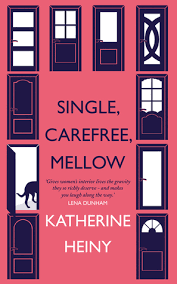Single, Carefree, Mellow
 Having been declared a ‘prodigy’ following her first publication in the New Yorker (1992), Heiny has finally delivered her long-awaited debut collection ‘Single, Carefree, Mellow.’ This collection is populated by middle class New York women, most of whom are striving for success in their lovers’ beds rather than in their work. The majority have embarked upon illicit affairs in order to escape their mundane domestic existence; most of them without a hint of remorse. These women may not be ‘Single’ but at least they are relatively ‘Carefree’ and definitely ‘Mellow’.
Having been declared a ‘prodigy’ following her first publication in the New Yorker (1992), Heiny has finally delivered her long-awaited debut collection ‘Single, Carefree, Mellow.’ This collection is populated by middle class New York women, most of whom are striving for success in their lovers’ beds rather than in their work. The majority have embarked upon illicit affairs in order to escape their mundane domestic existence; most of them without a hint of remorse. These women may not be ‘Single’ but at least they are relatively ‘Carefree’ and definitely ‘Mellow’.
As I was unfamiliar with Heiny’s work prior to this collection, I must admit I had succumbed initially to the eye-catching cover. The abundance of closed doors, except for a singular one left slightly ajar with a dog walking through it, had piqued my curiosity. I was further enticed by Lena Dunham’s – of ‘Girls’ fame – review on the front cover and in a way Heiny’s work reminded me of Dunham’s, although Heiny’s alter-egos are arguably less polished.
Heiny pens stories with a realistic flair that allows a sense of relatability with these peculiar heroines. In the initial story “The Dive Bar” it becomes clear that Heiny’s protagonist and antagonist are each as vulgar as the other. In the meeting of the wife and the mistress the awkwardness is palatable yet it is clear both have adopted a polite manner. The offhand comments from the wife become increasingly harsh, culminating in the shocking line “He’s just cunt struck, is all”. The entire collection is pervaded with witty lines such as this which create an abundance of lively characters who leap from the page.
Whilst, I enjoyed Heiny’s collection, she adopts a familiar style of leaving the characters in a state of bliss at the climax of each story except for one. I feel this pattern somehow manages to dismantle the stories’ foundation, such as in “Blue Heron Bridge” when the reader believes the affair is over. This is due to the exposure of David’s secret but instead it ends with Nina running across the bridge into her lover’s waiting arms, written in language containing much poetic imagery. These happy endings completely disregard the issues that surround the majority of the affairs and the women’s own problematic psyches. It seems Heiny only adopts these conclusions to allow for her stories to culminate in a humdrum way.
The lack of moral compass within Heiny’s work is startling yet comic, especially within “Blue Heron Bridge” where the main protagonist Nina is made up of a mixture of characteristics somewhere between those of a snob and a do-gooder. She looks down on her neighbour Bunny Pringle and highlights her need to feel she is above Bunny as she states “the most interesting thing about Bunny Pringle is you had to state both her first and last name.” Although she allows a minister to live with her and her family while his residence is being fixed, she does have certain vices; she is simultaneously embarking on an affair with her neighbour. In essence this highlights the extent of suburban politics.
Unlike Dunham, Heiny completely disregards feminism within her stories. Instead, all of her creations are women who are highly intelligent yet choose to submit to their lovers’ wishes; even when it is clear they are not particularly fond of them. “Dark Matter” – one of my favourites – highlights the existence of ‘come facts’ that the central character, Maya, has to endure from both lover and fiancée. These are basic facts with no punchline at which you roll your eyes, along with Maya. You can’t help but wonder why Heiny continues to write protagonists who can only feel a sense of fulfilment through male attention rather than from their own work. It is evident that none of these women are satisfied sexually or otherwise.
Koreen Low

Leave a Reply